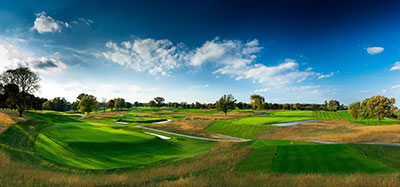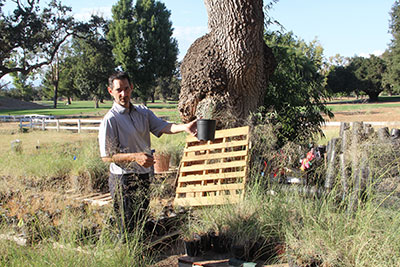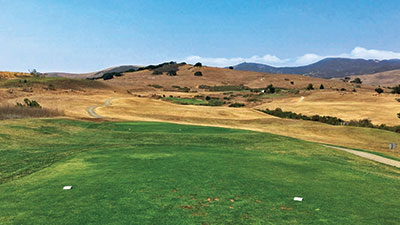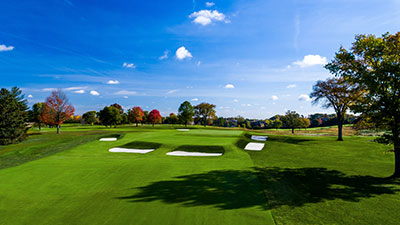Less turf + better turf = better for golf

Jared Milner, superintendent at Meadowbrook CC, Northville, Mich., is happy with the new rough at the course. “If we go through a drought, the bluegrass might get set back, but the fine fescue comes in.”
In an effort to make golf better for the budget and better for the golfer, courses take a close look at where the green goes.
The California drought, thankfully, is over.
And so is a state program that rewarded California golf courses with thousands of dollars for removing irrigated turfgrass. But that program has still inspired a wave of critical thinking on the way golf courses possibly can save water, labor, energy and money.
“It’s interesting to have these (water reduction) discussions in Michigan, in Wisconsin, in the Midwest, when I’m used to having them on the West Coast,” says architect Andy Staples, ASGCA, Staples Golf Design. “There’s no question, reducing water has resonated with the courses I’ve worked with.”
“In golf, everything is site-specific — no two golf courses are the same,” says Jay Blasi, ASGCA, Jay Blasi Design. “But the general idea or concept of only watering turf because it’s in play? That translates anywhere. Scotland and Australia figured this out a long time ago. More golf courses are closing than opening. Finding better ways to keep courses irrigated is paramount to the success of the industry.”
Less is more
Los Robles Greens Golf Course in Thousand Oaks, Calif., is known for the mighty oak trees that line the fairways (“los robles” translates to “the oaks” in Spanish). But those out-of-play areas under the oaks were a stumbling block for course Superintendent Ron Kerley.
“When I came here in 2006 we started maintaining it as xeriscape, first leaf litter, then wood chips,” Kerley recalls. “The customers complained that the wood chips were too big, so then we went to bare dirt for three or four years.”
California was in the throes of a drought, so Kerley was looking for a way to make these areas attractive, playable and drought tolerant. It was at the 2015 Golf Industry Show in San Antonio where Kerley met Gary Peterson, president of American golf construction at American Landscape Inc., and plans for a formal renovation starting bouncing around.
Added inspiration came because the course qualified for a turf reduction rebate — barely. The money for privately owned properties already had dried up. Because Los Robles is owned by the city of Thousand Oaks, a municipality, it still was able to apply for a turf-reduction rebate. Kerley and his team submitted the paperwork at 9:30 p.m. on the final day of eligibility. Their project was accepted, and they went to work the next day.

Architect Jason Straka (inset) discusses the native grasses selected for Los Robles Greens. Straka visited Pinehurst (N.C.) Resort to emulate the work done there.
The course, managed by Arcis Golf, applied for a 25-acre rebate, but the metro water district approved only 21 acres. By the end of the project, with the help of Fry/Straka Global Golf Course Design, the course removed 30 acres of turf, primarily out-of-play areas under trees along fairways.
They scalped the turf with a flail mower, applied pre-emergent and installed new irrigation according to new landscaping lines. Brian Broderson of Broderson Association Landscape Architecture and his team spent a month coaching Kerley’s crew on how to plant the new native grasses, a mixture of California Native Fescue and Melic grass (cool-season) and Sporobolus airiodes and Muhlenbergia rigens (warm-season).
The crew had to push hard — much-needed rains caused multiple delays — but the project finished on time. Last fall, a nifty check arrived in the mail.
While the project is complete, work to maintain these new native areas is ongoing.
“Anybody who knows anything about kikuyu grass knows that you can dump gasoline on it, light it on fire, and it’ll still come back,” Kerley says. “Guys who have been through this before have told me it takes two or three years. We try to minimize our chemical use, but sometimes we can’t help it and we put down a pre-emergent.”
The course keeps a nursery of native grasses and continues to put out new plantings. Kerley says the native grasses look best as the seasons change and they go in and out of dormancy. A native Midwesterner who has worked on golf courses coast to coast, he believes courses outside California could benefit from projects like the one they completed.
“I’m from Evansville, Ind. I have some family friends who own a share of a golf course back home,” Kerley says. “I was out there just last December for Christmas and we were driving the course together. There were areas that would be perfect for native areas. I think projects like this could benefit courses anywhere.”
Better turf, better conditions
Asking tough questions has established Andy Staples as one of the deep thinkers in golf in recent years. His white paper on the idea of “Community Links” — which proposes the golf course as the central gathering point for the local community — has him out talking to municipalities about how they can adapt their courses to be more viable in today’s market.

Dairy Creek GC in San Luis Obispo, Calif., is grappling with the challenge of removing irrigated turf but keeping the course viable for the community.
Dairy Creek Golf Course in San Luis Obispo, Calif., is rumored locally to be closing because of the drought. It is not — the county brought in Staples to ask some tough questions about what it might take for the course to survive.
“I was brought on to answer the question, ‘What if you lose all your water?’” Staples says. “Is that an 18-hole golf course and nothing else? What if you reduce the footprint like they’re doing at Dairy Creek, and integrate golf into parks, parks into the golf?”
But Staples is not the grim reaper of turf. And he’s not like the Bobs in the movie Office Space, a headhunter brought in to find areas where cuts immediately can be made to save the company a quick buck.
“I think it’s interesting that ‘efficient use of water’ has suddenly become ‘taking out turf,’” says Staples. “I understand if you have 180 acres of irrigated turf. But I’m not sure the course that has 90 acres should try to reduce to 60. That’s like trying to take blood out of a turnip.”
At a recent Staples project, Meadowbrook CC in Northville, Mich., the answer was changing turf types. Staples used Tee-2-Green’s Pure Distinction bentgrass on greens and Pureformance Blend on fairways and tees. The rough was seeded with a fine fescue/bluegrass blend and irrigation was removed.
“They’re using 60 percent less water and it is so much firmer now,” Staples says. “And we did open up the conversation of out-of-play areas and converting them to fescue. They had those areas so we converted 25 acres and the results are there — it looks and plays great.”

Meadowbrook’s greens are Tee-2-Green’s Pure Distinction bent and fairways and tees are Pureformance blend, a winning combination, Milner says.
Meadowbrook Superintendent Jared Milner agrees, and says the golfers enjoy the converted course.
“We pride ourselves on as firm and fast as possible, and a little brown is OK,” Milner says. “The course is much firmer and faster. Some of the ladies over age 60 told me they recently shot their lowest score. It’s because they’re getting more roll in the fairway.”
If the course goes through a drought, Milner says, the bluegrass in the rough might get knocked back, but the fine fescue comes in.
Added labor does come in the areas that are run-off areas for bad golf shots, or for walk-off areas for golfers. Those areas need to be kept tightly mowed. Milner keeps 25 people on the crew to manage the needs of the course.
“For the eye, the course looks tough,” Milner says. “I’m an 18- to 20-handicap and I like the way it plays. It’s a fun golf course, that’s what you hear the most. A lot of bump-and-run. It’s a unique course for the state of Michigan, even the Midwest.”
Redirecting effort
At last September’s grand reopening of Los Robles Greens, Kerley was presented with a framed before-and-after artist’s rendering of No. 9 at the course. “To Ron Kerley, with our thanks,” reads the plaque. “Words cannot convey our gratitude for your hard work.” On the left, the before image, is wall-to-wall dark green grass. On the right, the after, there’s a lot more brown stretching around the green, front and back.
On the before, the sun is burning through a cloudy sky. On the after, a cool blue sky depicts more ideal, superintendent-friendly weather for a more superintendent-friendly course.
“I’ll be honest, (the presentation) meant a lot to me,” Kerley says. “It meant a lot to all of us at Arcis Golf. This is what we wanted, and if it wasn’t for everyone pushing hard, we would have missed the deadline (for the rebate.)
“For me on the superintendent side, I’ve been able to redirect water usage to places where I struggled before… I’ve been able to give the historically drier areas a little more water, even though water prices continue to rise,” says Kerley. “From a player perspective, a lot of the places we took out just weren’t in-play areas. The players love it. Some tell me it’s the best they’ve ever seen the course. OK, we’ve finally had rain, but beyond that? The course is in really good shape. It’s definitely better than it was two years ago.”
Photos by: Brian Walters Photography (1,4), Staples Design (3) and Seth Jones (2)









